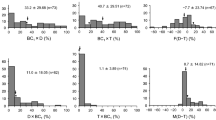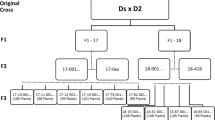Abstract
Diploid potato clones with 2n-pollen formation by first-division restitution without crossing-over (FDR-NCO) are ideal testers to estimate the breeding value of elite 4x cultivars by virtue of transmitting their genotypes practically intact to their progenies. This characteristic facilitates genetic analysis, since meiotic recombination would take place only in the 4x parent and not in the diploid parent. We evaluated (under short-day conditions) families from complete factorial crosses between four 4x cultivars and five 2x(FDR-NCO) clones. Families were compared with two standard 4x cultivars (’Bintje’ and ’Delta’) for total tuber yield (TTY), commercial yield (CY), haulm maturity (HM), plant vigor (PV), plant-top uniformity (PU), eye depth (ED), number of tubers per hill (NTH), and the CY/TTY index (CTI). For TTY, the contrasts family group (310 g/ hill) vs ’Delta’ (430 g/hill) and the family group vs ’Bintje’ (210 g/hill) were significant. Only 25% of the families were different from ’Delta’ and 20% of them outyielded ’Bintje’. For CY, differences were observed between families (240 g/hill) vs ’Delta’ (340 g/hill) and families vs ’Bintje’ (150 g/hill). The two best families had 53% CY over ’Bintje’. Surprisingly, only one family had a higher NTH than ’Bintje’. No differences were observed for HM. Seventy five and 30% of the families had an ED similar to ’Delta’ (ED = 2) and ’Bintje’ (ED = 1), respectively. A multivariate analysis indicated that 63% of the data variability could be explained by two factors. TTY, CY, and PV had high loading on the first factor, whereas ED, PU and HM had high loading on the second factor; CTI and NTH had equal sizes on both factors. High TTY and PV were associated with high NTH and CTI. Deep eye, PU, and late maturity were associated with high NTH and reduced CTI. The distributions of factor scores of the entries indicated that some 2x parents had strong influences (irrespective of the direction of their effects) on the crosses. Six crosses due to two 2x males were in the ’Bintje’ quarter with negative scores for both factors (implying low TTY, poor vigor, and low NTH). Also three crosses due to another 2x clone were distributed in the quarter of positive factor 1 and negative factor 2. These crosses plus another one were in the same quarter of ’Delta’ (implying high yields, low ED, low PU, and early maturity). The FDR-NCO clones provide a homogeneous sample of heterozygous 2n-gametes allowing the unique opportunity to estimate the relative contribution of the random meiotic products (from the 4x parents) and the ’somatic’ 2x genome for the phenotypic expression of quantitative traits. The interesting result was that measurable effects (favorable or not) on the data variability were mainly determined by the genomic contribution of the haploid-species hybrids. Three out of five 2x-male parents showed rather strong effects on progenies. No such effects were observed on the four 4x-female parents.
Similar content being viewed by others
Author information
Authors and Affiliations
Additional information
Received: 3 September 1999 / Accepted: 24 November 1999
Rights and permissions
About this article
Cite this article
Buso, J., Boiteux, L., Tai, G. et al. Direct estimation of the effects of meiotic recombination on potato traits via analysis of 4x-2x progenies from synaptic mutants with 2n-pollen formation by FDR without crossing-over. Theor Appl Genet 101, 139–145 (2000). https://doi.org/10.1007/s001220051462
Issue Date:
DOI: https://doi.org/10.1007/s001220051462




